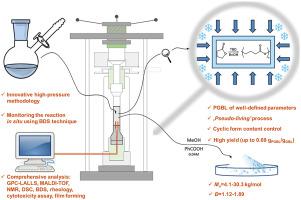Polymer ( IF 4.6 ) Pub Date : 2021-09-08 , DOI: 10.1016/j.polymer.2021.124166 Roksana Bernat 1, 2 , Paulina Maksym 2, 3 , Magdalena Tarnacka 2, 3 , Kajetan Koperwas 2, 3 , Justyna Knapik-Kowalczuk 2, 3 , Katarzyna Malarz 2, 3 , Anna Mrozek-Wilczkiewicz 2, 3 , Andrzej Dzienia 2, 4 , Tadeusz Biela 5 , Roman Turczyn 6 , Luiza Orszulak 1 , Barbara Hachuła 1, 2 , Marian Paluch 2, 3 , Kamil Kamiński 2, 3

|
In this paper, we report 1,5,7-Triazabicyclo[4.4.0]dec-5-ene (TBD) supported high-pressure approach enforcing Ring-Opening Polymerization (ROP) of γ-butyrolactone (GBL), that due to unfavorable thermodynamics and low ring strain, is considered as a hardly polymerizable monomer. Application of Broadband Dielectric Spectroscopy (BDS) allowed us to find optimal thermodynamic conditions to perform well-controlled and notably fast polymerization (even within 1 h!), avoiding undesired crystallization process. It was shown that by varying pressure and temperature conditions, we could control molecular weight, dispersity of recovered macromolecules, as well as rate and efficiency of the reaction that are significantly altered with respect to the reference process carried out at ambient conditions. Experiments performed at respectively very low temperature T = 233 K and low/moderate pressure (p = 75–250 MPa) and much higher temperatures (T = 248–268 K) and compressions (p = 1000 MPa) yielded poly(γ-butyrolactone) (PGBL) of tailored absolute molecular weight in moderate range Mn = 2.8–15.0 (up to 30.3) kg/mol and narrow/moderate dispersity ranging from Đ = 1.12–1.89. What is more, the implementation of MALDI-TOF, GPC and DSC analyses, clearly indicated that as i) the time of reaction gets longer, ii) the amount of catalyst increases, iii) the temperature lowers, the content of cyclic products in produced polymers grows. This phenomenon influences the rheological properties (viscosity), foil formation ability (films) and cell culture proliferation features of the recovered macromolecules. Presented results open a highly effective and repeatable route to produce PGBL via pressure-assisted ROP and indicate the possibility of tuning properties of this polymer by varying concentration of cycles or eventual block copolymerization with other biorelevant monomers to meet the expectations of the biotechnological industry.
中文翻译:

高压对γ-丁内酯有机催化ROP的影响
在本文中,我们报告了 1,5,7-三氮杂双环 [4.4.0]dec-5-烯 (TBD) 支持的高压方法强制 γ-丁内酯 (GBL) 的开环聚合 (ROP),这是由于不利的热力学和低环应变,被认为是一种难以聚合的单体。宽带介电光谱 (BDS) 的应用使我们能够找到最佳的热力学条件,以进行良好控制且非常快速的聚合(甚至在 1 小时内!),避免不希望的结晶过程。结果表明,通过改变压力和温度条件,我们可以控制分子量、回收大分子的分散性以及反应的速率和效率,这些都相对于在环境条件下进行的参考过程发生了显着改变。分别在极低温度下进行的实验T = 233 K 和低/中等压力 ( p = 75–250 MPa) 和更高的温度 ( T = 248–268 K) 和压缩 ( p = 1000 MPa) 产生了定制绝对值的聚(γ-丁内酯)(PGBL)分子量在中等范围M n = 2.8–15.0(高达 30.3)kg/mol,窄/中等分散范围为Đ = 1.12–1.89。更重要的是,MALDI-TOF、GPC和DSC分析的实施,清楚地表明,随着i)反应时间变长,ii)催化剂用量增加,iii)温度降低,生产的聚合物中环状产物的含量增加。这种现象会影响回收的大分子的流变特性(粘度)、箔形成能力(薄膜)和细胞培养增殖特性。所呈现的结果开辟了一条通过压力辅助 ROP生产 PGBL 的高效且可重复的途径,并表明通过改变循环浓度或最终与其他生物相关单体的嵌段共聚来调整该聚合物性能的可能性,以满足生物技术行业的期望。



























 京公网安备 11010802027423号
京公网安备 11010802027423号